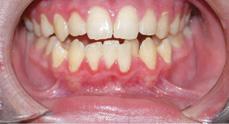Periodontal and Gingival Health and Diseases
Nadeem Y. Karimbux and David M. Kim
The normal periodontium consists of gingiva, connective tissue, the periodontal ligament, cementum, and the surrounding alveolar bone. Clinicians commonly describe the healthy gingiva as being scalloped, coral pink in color, firm, and knife-edged. The lack of bleeding on probing and the lack of exudates are also taken as clinical signs of health. There are several different forms of gingival and periodontal diseases that can be present in children and adolescents that can change the appearance (erythematous), contour (swollen), size (hyperplastic or overgrown), and shape (blunted papillae) of the gingiva. They range from reversible conditions limited to the inflammation of gingival tissues (gingivitis) to those characterized by the destruction of the periodontal connective tissue attachment and alveolar bone (periodontitis).1
According to the American Academy of Periodontology, periodontal disease in children and adolescents can be classified into five distinct periodontal disease categories (eTables 377.1 and 377.2  )2:
)2:
1. Dental plaque-induced gingival diseases
2. Chronic periodontitis
3. Aggressive periodontitis
4. Periodontitis as a manifestation of systemic diseases
5. Necrotizing periodontal diseases
 EPIDEMIOLOGY
EPIDEMIOLOGY
Even though epidemiological studies indicate that gingivitis of varying severity is nearly universal in children and adolescents, these studies also indicate that the prevalence of destructive forms of periodontal disease is lower in young individuals than in adults.2 The reported prevalence of periodontitis in children and young adults varies by age. Children ages 5 to 11 years have a reported prevalence rate of up to 9%; those ages 12 to 15 years have a prevalence rate up to 46%.3-10 Thus, children and adolescents should receive a periodic periodontal evaluation as a component of routine dental visits, because periodontitis is usually preceded by gingivitis.
A national survey showed that gingivitis that is found in early childhood is more prevalent and severe in adolescence and then tends to become less severe in older age groups.11 Chronic periodontitis in children and adolescents is more common than the other three forms of periodontitis listed above, and it is clinically similar to the chronic periodontitis seen in adults.12 The prevalence of aggressive periodontitis varies significantly between various demographic groups.13 Periodontitis as a manifestation of systemic diseases and necrotizing periodontal diseases occur more often in children than in adults, though both are relatively uncommon.14,15
Periodontitis is a multifactorial disease, and there are several local and systemic factors that are associated with it. For example, local contributing factors such as caries, inadequate restoration, and subgingival calculus may contribute to a bacterial accumulation that will result in a host-mediated inflammatory response16,17 (eFig. 377.1  ). Ethnic and socioeconomic factors have also been associated with the incidence and prevalence of periodontitis.19 African American children have a higher prevalence of localized aggressive periodontitis than Caucasian children.20,21 Patients with various disorders are at increased risk for peridontitis that usually manifests before puberty. Most of these disorders are due to genetic defects that likely alter local factors, initiating the periodontal inflammation.12 These include diabetes mellitus, neutropenias and neutrophil disorders, leukemias, Down syndrome, Papillon-Lefèvre syndrome, Chediak-Higashi syndrome, histiocytosis syndrome, glycogen storage disease, Ehlers-Danlos syndrome (types IV and VII), and hypophosphatasia.1 Systemic diseases such as measles and impaired endocrine balance, in combination with malnutrition, can also render the host susceptible to the onset of these diseases.12
). Ethnic and socioeconomic factors have also been associated with the incidence and prevalence of periodontitis.19 African American children have a higher prevalence of localized aggressive periodontitis than Caucasian children.20,21 Patients with various disorders are at increased risk for peridontitis that usually manifests before puberty. Most of these disorders are due to genetic defects that likely alter local factors, initiating the periodontal inflammation.12 These include diabetes mellitus, neutropenias and neutrophil disorders, leukemias, Down syndrome, Papillon-Lefèvre syndrome, Chediak-Higashi syndrome, histiocytosis syndrome, glycogen storage disease, Ehlers-Danlos syndrome (types IV and VII), and hypophosphatasia.1 Systemic diseases such as measles and impaired endocrine balance, in combination with malnutrition, can also render the host susceptible to the onset of these diseases.12
 PATHOPHYSIOLOGY
PATHOPHYSIOLOGY
Bacterial accumulation that results in a cascade of host-mediated inflammatory response is the pathway of periodontal soft and hard tissue destruction. Aggregatibacter actinomycetemcomitans, Prevotella intermedia, Porphyromonas gingivalis, Tannerella forsythensis, and Treponema denticola are gram-negative organisms that have been found in children and young adults with periodontal attachment loss.24 However, only a subgroup of microorganisms might be responsible for the initiation of the tissue destruction in chronic periodontitis.46,47 The predominance of a gram-negative bacterial flora (Aggregatibacter actinomycetemcomitans, Tannerella forsythensis, Porphyromonas gingivalis, Prevotella intermedia, and Fusobacterium nucleatum) in combination with the cellular and cytokine profiles of the lesions indicates the likelihood that bacterial lipopolysaccha-ride activation of monocytes and subsequent production of tissue-destructive cytokines is likely to be a major pathway of destruction.48
Results of several studies suggest that Aggregatibacter actinomycetemcomitans is a major etiologic factor in the pathogenesis of aggressive periodontitis.49,50 Functional abnormalities in neutrophils and monocytes taken from localized aggressive periodontitis patients have been reported, such as increased adherence, abnormal signal transduction, depressed chemotaxis, and other related functions.51-54 Microbiological and histological studies in patients with necrotizing periodontal disease have shown the presence of spirochetes, gram-positive cocci, β-hemolytic streptococci, Borrelia species, P gingivalis, P intermedia, and Candida albicans.63
The genetic component of periodontal disease can impact the initiation, path of progression, and response to treatment.27,28 A study in twins estimated that 38% to 82% of the population variance in clinical measures of periodontal diseases might be attributable to genetic factors.33
 CLINICAL MANIFESTATIONS
CLINICAL MANIFESTATIONS
Dental Plaque-Induced Gingival Diseases
Typical features of gingivitis may include gingival redness, swelling, marginal bleeding, and pseudopockets in the absence of bone loss, which might be reversible following appropriate therapy (Fig. 377-1).1 Mild and moderate forms of gingival inflammation are an almost universal finding in young people.3,38 Normal and abnormal fluctuation in hormone levels, including changes in gonadotrophic hormone levels during the onset of puberty, can enhance the gingival inflammatory response to dental plaque.43,44

Stay updated, free articles. Join our Telegram channel

Full access? Get Clinical Tree


